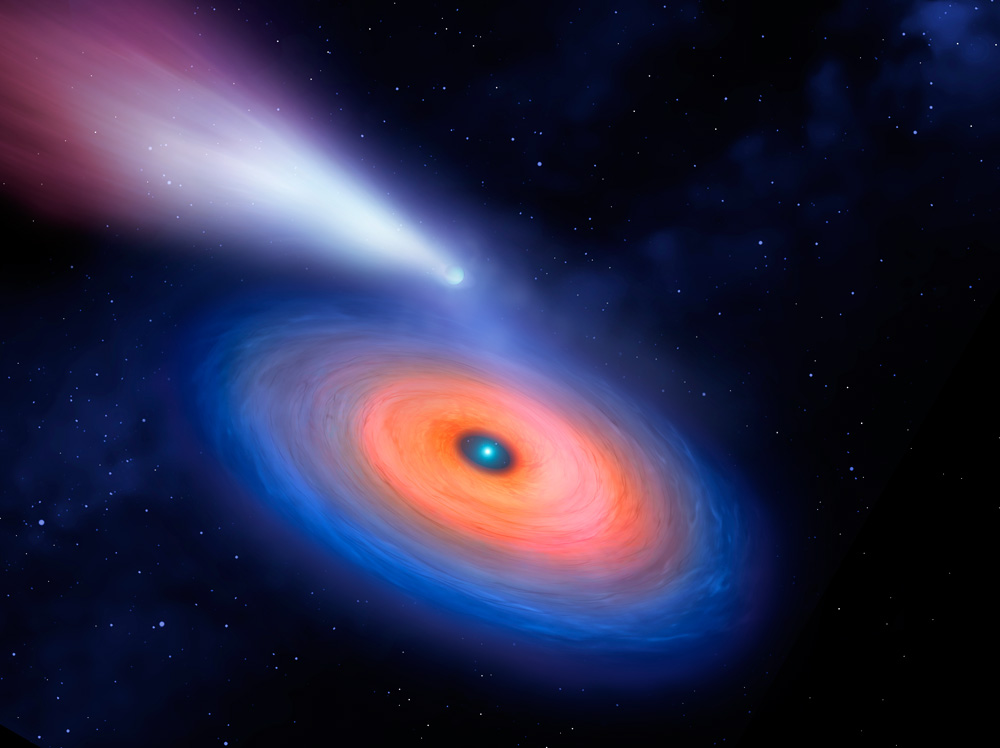Astronomers have long suspected that white dwarfs eat their planetary companions. Now, indirect observations show the process in action.

University of Warwick / Mark Garlick
A trail of blood in the snow surely tells you someone is wounded. Likewise, the discovery of an unusual stream of gas onto a white dwarf star betrays the presence of a “bleeding” planet. This week, astronomers report the first-ever, albeit indirect, evidence for a planet orbiting a white dwarf – the dense remnant of a Sun-like star that has used up its nuclear fuel.
In the December 5th Nature, a team of astronomers led by Brian Gänsicke (University of Warwick, UK) describes their spectroscopic study of a 19th-magnitude hot white dwarf known as WD J091405.30+191412.25, located some 1,500 light-years away in the eastern part of Cancer. Observations with the X-Shooter spectrograph on the European Southern Observatory (ESO) Very Large Telescope reveal the existence of a circumstellar disk of gas, just some 20 million kilometers across.
Astronomers have long suspected that white dwarfs cannibalize any remnant planets in orbit around them. Indeed, disks of infalling planetary debris have been found around white dwarfs before, but they always had a rocky composition. Instead, the disk around WD J0914+1914 appears to consist solely of hydrogen, oxygen and sulfur – the elements found in the deeper atmospheric layers of icy giant planets like Neptune. Moreover, the white dwarf is accreting material from the disk at an unprecedented rate of 3,000 tons per second.
According to the authors, “the most plausible origin of the material in [the] disk is an evaporating giant planet on a close-in orbit around the white dwarf.” The planet is evaporating is due to ultraviolet radiation from the star, which has a surface temperature of 28,000 degrees. It must be a strange sight: the relatively low-density planet is expected to be about four times as large as the ultra-condensed white dwarf.
So how does an icy giant planet end up on such a tight orbit, circling the star in only 10 days? After all, such a close orbit would have put the planet inside the star during its red giant phase. The team suggests the planet was pulled inward later due to gravitational interactions with other planets in the system. A similar fate may await the giant planets in our own solar system, after the Sun turns into a white dwarf some 5 billion years from now.
According to exoplanet researcher Yamila Miguel (Leiden Observatory), “the relevance of the discovery lies in the fact that the disk is providing clues on the planet’s composition.” Lisa Kaltenegger (Cornell) is also intrigued by the discovery of planets orbiting white dwarfs. While this particular one is surely inhospitable, “such planets could maintain habitable conditions for billions of years,” she says.
As part of their study, Gänsicke and his colleagues examined Sloan Digital Sky Survey spectra of 7,000 white dwarfs but didn’t find another system that resembles WD J0914+1914. They hope that more will show up in data for 260,000 white dwarfs identified by the European Space Agency’s Gaia space telescope.
Of course, it would also be great to find more direct evidence for the existence of the evaporating planet. Unfortunately, says Gänsicke, detecting stellar radial velocity variations “will be very challenging: the white dwarf is much fainter than typical exoplanet host stars, and it has fewer absorption lines in its spectrum that can be used for the velocity measurements.” Hopefully, he says, ESO’s new ESPRESSO spectrograph will be able to pull this off.
 0
0
Comments
You must be logged in to post a comment.